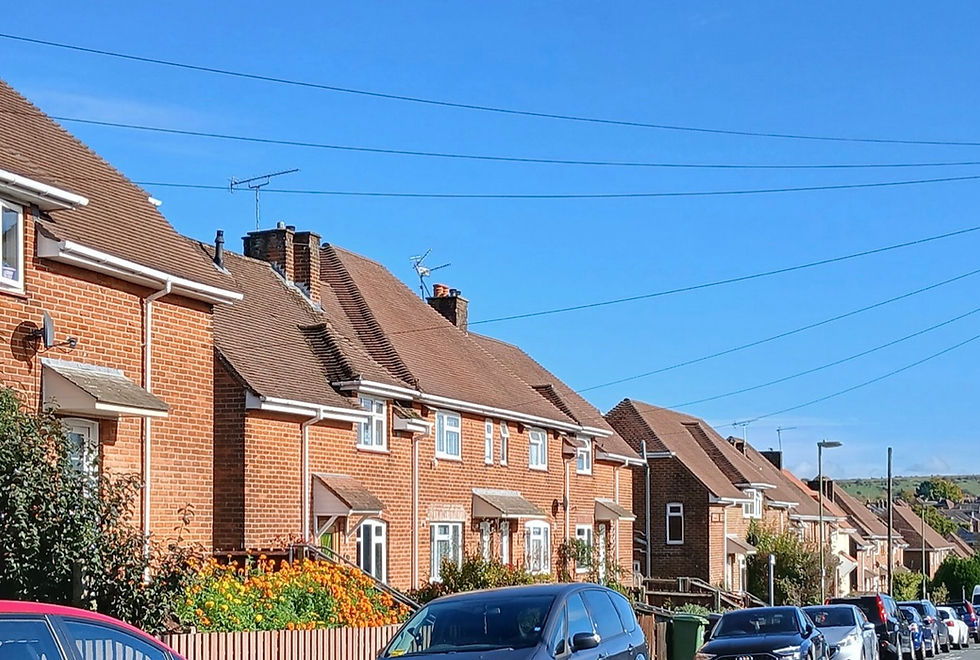Lost Nature: Do House Builders deliver?
- Dec 20, 2024
- 4 min read
It was back in March that we visited the Cala Homes development site in Alton. Construction work was still going on at that time, though some properties were already occupied. It was great to see lots of Swift bricks have gone in, though I think it might not be quite at a ratio of one per dwelling as stated in their Urban Wildlife Strategy document which you can read here. I might be wrong on this thought, as to be fair it’s not always possible to see all four sides of the property.

The Swift bricks that I saw all seem to be the Ibstock Swift bricks. These are expensive at approx. £130 each, though perhaps Cala got a good discount. This is 3-4x as expensive as the Manthorpe or the ‘S’ bricks from Action for Swifts, which is a huge difference. On this block below (Newcastle House) for instance, which seems to comprise several flats, there seemed to be just one Ibstock brick positioned on the front just to the right of the upper left balcony railings. Rather than go for what is just about the most expensive Swift brick on the market on these houses they could have used one of the cheaper alternatives which are just as good.

There may have been others at the rear that I couldn’t see, though on the high gables around the corner to the left which look perfect for Swift bricks (next picture) there were none. These gables could have housed several of the much cheaper Manthorpe or ‘S’ bricks. To be fair, their Strategy does say that they would provide “An average of one swift nesting feature per house and apartment building.”

I have fed some constructive comments back to Cala Homes and they were received in the positive spirit that they were meant. I sincerely hope that Cala Homes will do their own independent audit of what has actually been installed on this site compared to what they said they would install in their Strategy document, so that if improvements are required in the future they can work out what needs to be done to make that happen. Maybe it would show that everything in the way of Swift bricks, bat roosting features, invertebrate bricks, hedgehog friendly fencing and planting have been installed as planned. I do hope so, and if that is the case then full marks to Cala Homes.
But this issue of whether developers are actually doing all they say they are doing has reared its head again with the publication last week of another report, this time commissioned by Wild Justice and written by researchers at the University of Sheffield. The Lost Nature Report has revealed that:
• Housing developers are not keeping legally-binding promises to help wildlife on housing developments.
• A survey of nearly 6,000 houses across 42 developments found that only half of the promises to mitigate harm to nature had been kept. Many ecological enhancements had simply not materialised, with 83% of Hedgehog highways, 100% of bug boxes, and 75% of both bat and bird boxes found to be missing from new developments.
• The delivery of plant life across sites also painted a depressing picture: 39% of the trees detailed on planting plans were missing or dead, and nearly half of the native hedges that were supposed to be laid did not exist.
75% of bird boxes were found to be missing! That is disgraceful. And this is compared to what they were required to install according to the planning consents. The researchers don’t name the house builders but clearly some were much better than others.
“The distribution of compliance varied wildly: the least compliant site scored 0%, while the best scored 95%. These high scores are not, however, a sign that all is well on those developments. The method used measured compliance with planning conditions, rather than ecological value. This meant that quite unambitious schemes could score highly, provided that developers had done a small number of things for nature.
There was very little variation in the compliance of sites by type of developer, size of development (number of houses), area of the development site (in hectares), or geography (area of the country). Wild Justice says this reveals a systemic issue across the planning and development system as a whole.
Wild Justice believe that the new Biodiversity Net Gain system introduced in 2024 is being used to justify increased levels of development on the grounds that ecological harms can be mitigated. They say that the Lost Nature report highlights a worrying gap in the implementation and enforcement of these biodiversity enhancements, meaning very often the ‘net gain’ will exist only on spreadsheets. The reality on the ground seems to be that nature is losing out.”
Professor Malcolm Tait from the School of Geography and Planning at the University of Sheffield said: “The government has just announced ambitious housing targets, on the assumption that the planning system can ensure harms to nature are mitigated. But our research shows that housebuilders aren’t implementing the ecological enhancements to help nature that they have promised. What we have revealed is a huge, systemic issue and an urgent need for the planning enforcement system to be given the resources it needs to protect wildlife from harm.”
A spokesperson from Wild Justice said: “‘This is regulatory failure – developers cheat the system and nothing happens – except wildlife loses out, yet again.”




When it comes to classic wardrobe staples, crew neck t-shirts are unmatched in their versatility and comfort. These t-shirts feature a round, close-fitting neckline that sits comfortably at the base of the neck, making them an ideal choice for layering or wearing solo. Loved for their clean and timeless design, crew neck tees are a must-have for casual wear, workouts, or even as part of a more polished, minimal outfit.